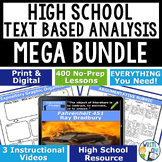Great Expectations by Charles Dickens - Text Based Evidence & Analysis Writing
- Zip
- Google Apps™

Also included in
- Teaching text dependent analysis writing has never been easier! This in-depth literature based writing prompt bundle includes lessons for 400 of the most popular novels, short stories, and poems taught in middle school! The lessons include argumentative, expository, and compare & contrast prompPrice $71.91Original Price $1555.80Save $1483.89
Description
Teaching how to write a literary analysis essay citing text evidence for Great Expectations by Charles Dickens has never been easier! This in-depth text dependent analysis (TDA) writing prompt resource guides students through a step-by-step process of writing an expository essay with textual evidence as support. It includes an expository writing graphic organizer, rubric, expository writing quiz, and an expository writing template.
All aspects of text evidence writing are covered in this resource: brainstorming ideas, developing a thesis statement, introducing supporting evidence, writing hooks and leads, and incorporating the 6 Traits of Writing™.
The video, slide show, graphic organizer, worksheets, writing template, and rubric allow students to practice and develop their expository writing skills. The writing quiz reinforces guided note-taking techniques when used in conjunction with the instructional video. The detailed lesson plans make implementing informative writing easy for teachers.
The lesson can be used in class, assigned for distance learning, or given as independent student work. The instructional video with writing tutorial and template can also be presented as whole class instruction or assigned for students to complete at home.
Each resource listed below is included in Google Drive™ and print format.
*****************************************************************************************
This Citing Text Evidence Expository / Informative writing prompt lesson includes:
Entertaining Instructional Video with:
- Brainstorming ideas
- Prompt identification and comprehension
- Thesis statement development
- Rubric explanation
- How to Write an Expository Essay tutorial and writing template
- How to Write an Expository Essay writing quiz / guided note-taking
Great Expectations by Charles Dickens Detailed Lesson Plan with:
- Common Core State Standards indicated on lesson plan
- Instructional Focus
- Instructional Procedures
- Objectives/Goals
- Direct Instruction
- Guided Practice
- Enrichment
- Differentiation
- ESE Strategies
- ELL Strategies
- I Can Statement
- Essential Question
Great Expectations by Charles Dickens Worksheets with:
- Prompt
- Brainstorming section
- Thesis statement development
- How to Write an Expository Essay tutorial and writing template
Great Expectations by Charles Dickens PowerPoint Presentation with:
- Introduction slide with prompt (interactive for students to identify key vocabulary)
- Brainstorming slide (interactive for students to list ideas)
- Standard and implied thesis development slides
- How to Write an Expository Essay tutorial and writing template slides
- Checklist slide
Expository Writing Quiz
Expository Rubric
Expository Graphic Organizer
Google Slides™
*****************************************************************************************
Check out my other High School Text Based Analysis Writing Prompts:
*****************************************************************************************
Connect with me for the latest Write On! with Jamie news:
. . . and visit my WRITE ON! with Jamie website for a free TEXT EVIDENCE WRITING LESSON!
Write On!
Jamie
© Google Inc.™ All rights reserved. Google™ and the Google Logo are registered trademarks of Google Inc.™ Write On! with Jamie® is an independent company and is not affiliated with or endorsed by Google Inc.™
Terms of Use
Copyright © Write On! with Jamie. All rights reserved by author. All components of this product are to be used by the original downloader only. Copying for more than one teacher, classroom, department, school, or school system is prohibited unless additional licenses are purchased. This product may not be distributed or displayed digitally for public view. Failure to comply is a copyright infringement and a violation of the Digital Millennium Copyright Act (DMCA). Clipart and elements found in this product are copyrighted and cannot be extracted and used outside of this file without permission or license. Intended for classroom and personal use ONLY.






